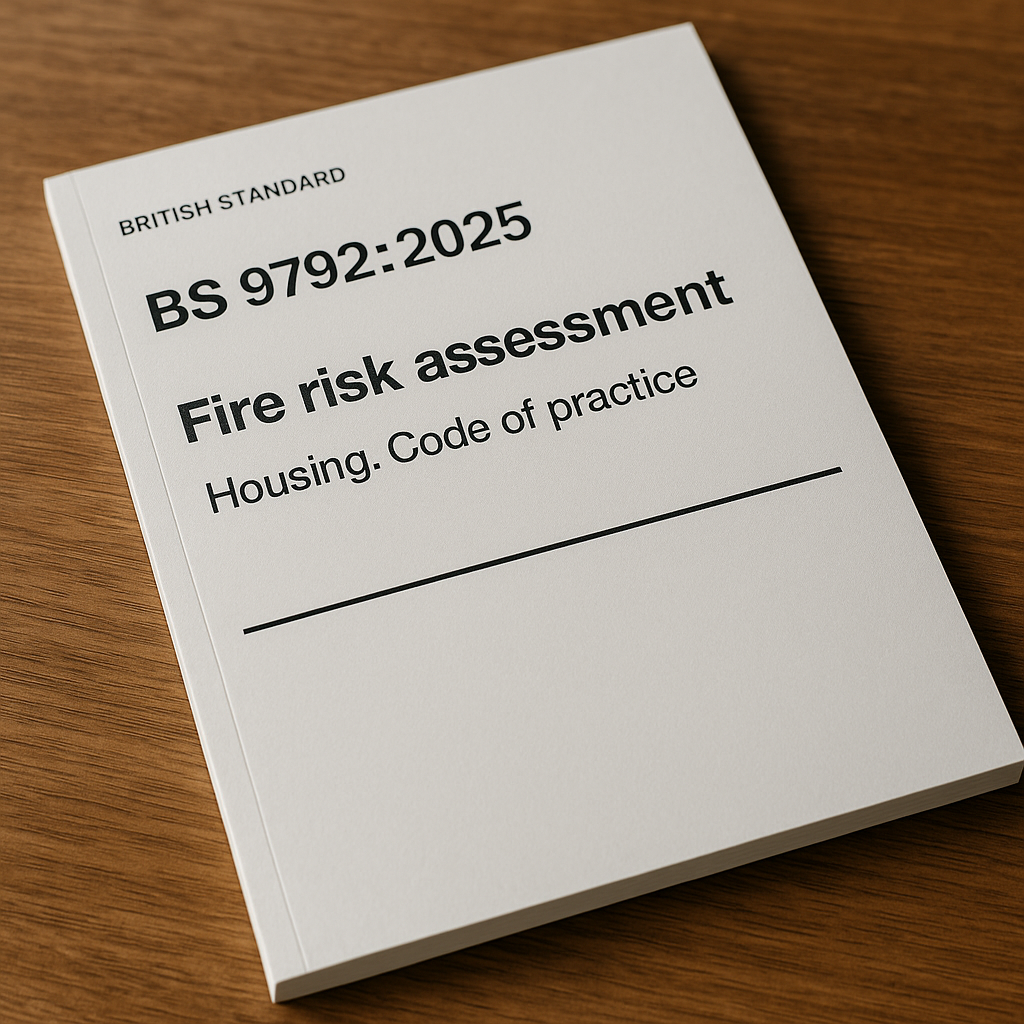On 1 August 2025, the British Standards Institution (BSI) published BS 9792:2025 – Fire Risk Assessment: Housing. Code of Practice.
This new standard replaces the withdrawn PAS 79-2:2020 and, for the first time, provides a formal British Standard for fire risk assessments in housing.
It represents a major step forward in aligning fire risk assessment practices with current UK fire safety legislation, including the Regulatory Reform (Fire Safety) Order 2005 and the Building Safety Act 2022.
Who is BS 9792:2025 for?
BS 9792:2025 is designed for:
-
Fire risk assessors and consultancy firms – ensuring consistency and defensibility in their reports.
-
Housing providers, freeholders, and managing agents – helping them meet legal obligations under UK fire safety law.
-
HMO and student accommodation landlords – providing a recognised framework for safer housing.
-
Competent persons conducting or overseeing fire risk assessments with suitable fire safety knowledge and training.
What does BS 9792:2025 cover?
The standard applies to fire risk assessments in the following types of residential premises:
-
Houses in Multiple Occupation (HMOs)
-
Blocks of flats and maisonettes (both purpose-built and converted)
-
Specialised housing (e.g., supported or sheltered housing)
-
Student accommodation
-
Access/common areas in mixed-use buildings
📑 Which fire risk assessment template or guidance applies?
Not every type of premises is covered by BS 9792:2025. Here’s a clear breakdown of what to use where:
| Premises Type | Recommended Standard / Guidance | Notes |
|---|---|---|
| Housing (HMOs, blocks of flats, student accommodation, specialised housing) | BS 9792:2025 – Fire Risk Assessment: Housing | Replaces PAS 79-2:2020. The new baseline for housing FRAs. |
| General non-housing premises (offices, shops, warehouses, schools, factories, etc.) | PAS 79-1:2020 – Fire Risk Assessment: Premises other than housing | Still current. Provides methodology and documentation for non-domestic buildings. |
| Short-term lets / Airbnb-style holiday accommodation | Government Sleeping Accommodation Guide | FRA required under the Fire Safety Order. Tailored for small B&Bs, self-catering lets, guest houses. |
| Single-family private dwellings (owner-occupied) | Not subject to Fire Safety Order – fire safety managed under Building Regulations Approved Document B | FRA not normally required unless used as an HMO or short let. |
| Care homes / residential care | BS 9991:2015 – Fire safety in the design, management and use of residential buildings + HTM 05-03 (Healthcare fire safety guidance) | Specialist requirements due to vulnerable occupants. |
| Construction-phase housing (before occupation) | HSE – Fire safety in construction + CDM Regulations 2015 | Responsibility sits with Principal Contractor during build. |
| External walls & cladding on existing blocks | PAS 9980:2022 – Fire risk appraisal of external wall construction | Specialist appraisal alongside the main FRA. |
| Covered car parks with EV chargers | TGN 0194: 2023 – Covered Car Parks: Fire Safety Guidance for EVs + RC59 | Supplements FRA where EV charging is provided. |
| Photovoltaic (PV) systems on buildings | BS 7671 (18th Edition) – Electrical installations + manufacturer guidance + FRA integration | No dedicated FRA standard – risks considered within overall building FRA. |
What’s new in BS 9792:2025?
Compared to PAS 79-2:2020, BS 9792:2025 introduces significant improvements:
-
Standardised pro forma – a new, clearer documentation format for recording fire risk assessments.
-
Stronger evacuation guidance – with a new annex focusing on residents with specific evacuation needs.
-
Updated references – incorporating the latest fire safety legislation and other British Standards since 2020.
-
Plain English commentary – less verbose, more direct, and accessible to both professionals and non-specialists.
-
Restructured content – aligning various FRA types with the principles and scope of the standard.
-
Legal alignment – reflecting changes introduced through the Building Safety Act 2022 and post-Grenfell regulatory updates.
Why BS 9792:2025 matters
Adopting BS 9792:2025 offers several benefits for housing providers, fire risk assessors, and managing agents:
-
Consistency – one nationally recognised method of carrying out and documenting FRAs in housing.
-
Compliance – ensures alignment with UK fire safety legislation.
-
Improved fire safety – reduces fire risk for residents and enhances occupant protection.
-
Clarity of communication – shared terminology across stakeholders.
-
Holistic and proportionate risk assessment – pragmatic, building-specific recommendations without unnecessary over-engineering.
-
Better documentation – higher quality reports, reducing liability for landlords and managers.
Conclusion
BS 9792:2025 is more than just an update—it’s a milestone in housing fire safety.
By moving from a withdrawn PAS to a full British Standard, the housing sector now has a clear, consistent, and legally aligned framework for assessing fire risks in HMOs, blocks of flats, student housing, and other residential premises.
👉 If you are still working from PAS 79-2 templates, you’re already behind.
The future of housing fire risk assessment is BS 9792:2025—and it’s here now
🔗 Further reading:


